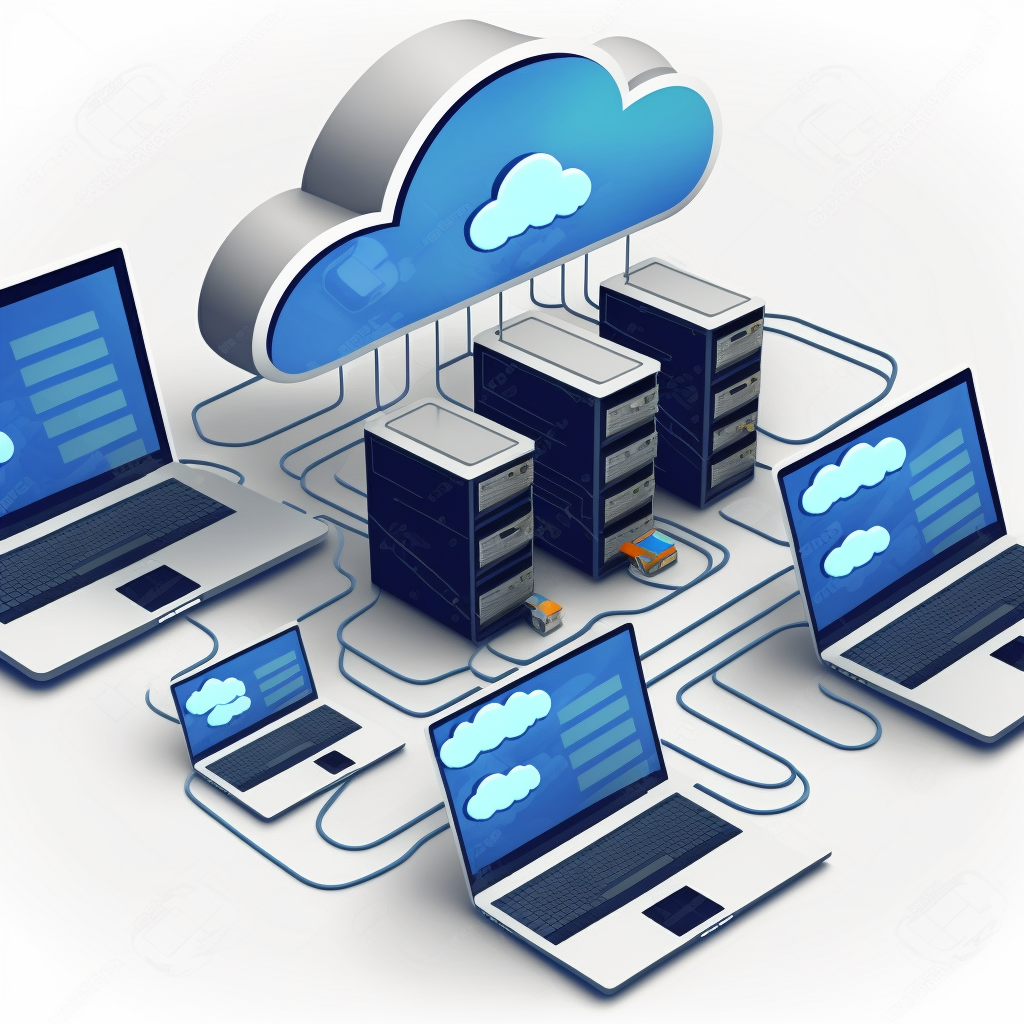How Cloud Computing can Save your Business Time and Money
Cloud computing has revolutionised the way businesses use and leverage technology to achieve their goals.
Companies used to rely on expensive, complex in-house infrastructures. They required significant investments in hardware, software, and personnel to maintain and manage. However, with the advent of cloud platforms, they can now access and utilise powerful resources and services in a more cost-effective and scalable manner.
Without the need for in-house hardware, cloud platforms allow businesses to
- store and process data remotely
- access powerful software applications
- collaborate seamlessly across teams and locations
This shift to the cloud has opened up new opportunities for businesses of all sizes. It’s enabling the little guys them to compete more effectively with titans in today’s digital marketplace. In this post, we’re going to explore ways in which cloud platforms have revolutionised how businesses use IT, and why they are essential for future success.
Cost Benefits of Cloud Computing
There are several cost benefits of cloud computing that businesses can take advantage of.
Reduced hardware costs
One of the biggest cost benefits of cloud computing is that businesses can reduce their hardware costs. Instead of purchasing and maintaining their own servers, businesses can rely on cloud providers to handle their computing needs. This eliminates the need for businesses to invest in expensive hardware and reduces ongoing maintenance costs.
Lower software costs
In addition to hardware cost savings, businesses can also save money on software costs by moving to the cloud. With cloud computing, businesses typically pay a subscription for access, rather than purchasing and installing software on their own servers. This can help businesses avoid large up-front software costs and save money over time
Pay-as-you-go pricing
Many cloud providers offer pay-as-you-go pricing models, which means businesses only pay for the computing resources they actually use. This can help businesses avoid overpaying for resources they don’t need and can result in significant cost savings.
Reduced energy costs
As mentioned earlier, moving to the cloud can help businesses reduce their energy costs. By relying on cloud providers to handle their computing needs, businesses can reduce electricity consumption and lower their overall energy costs.
Improved resource utilization
Cloud computing allows businesses to optimize their resource utilization, which can result in cost savings. With cloud computing, businesses can easily scale their resources up or down based on demand, ensuring they’re are only using the resources they need at any given time.
Overall, the cost benefits of cloud computing are numerous and can;
- help businesses reduce their hardware and software costs
- optimise their resource utilisation
- save money on energy costs
Additionally, the pay-as-you-go pricing model offered by many cloud providers means they can avoid overpaying for resources they don’t need. As well as that, once they are done with the resource it can be removed with no burden of having unused hardware.
Cloud Computing vs. Traditional IT: Which is More Cost Effective for your Business?
Cloud computing and traditional IT both have their own costs and benefits. Which one is more cost-effective for your business will depend on your specific needs and circumstances. Most of the time a hybrid solution is very viable. here are some factors that may help you decide.

On one hand, traditional IT typically requires businesses to purchase and maintain their own hardware and software. This can be expensive, including servers, networking equipment, and storage devices, as well as software licenses and ongoing maintenance costs. Additionally, traditional IT often requires businesses to have their own staff to manage and maintain their systems.
On the other hand, cloud computing allows businesses to rely on cloud providers for their computing needs. Cloud providers typically offer pay-as-you-go pricing models, which means businesses only pay for the computing resources they actually use. This can help businesses avoid overpaying for resources they don’t need and can result in significant cost savings. Additionally, businesses do not need to purchase or maintain hardware or software, as these are provided by the cloud provider. This can further reduce costs and free up resources for other business needs.
However, it’s important to note that cloud computing also has its own costs and considerations. For example, while pay-as-you-go pricing can be cost-effective, it can also be unpredictable and difficult to budget for. Additionally, some businesses may have specific security or compliance requirements that cannot be met by cloud providers, and may therefore need to rely on traditional IT solutions.
Real-world Examples of Businesses Saving Time and Money with Cloud Computing
Let’s take the example of a small business that needs to set up a website for their customers to visit. Traditionally, this would require the business to purchase and maintain their own server hardware, as well as pay for the ongoing costs of hosting and maintaining the website. This could be a significant expense for a business, especially if they don’t have the expertise to manage their own servers.
By using cloud computing, however, the business can avoid many of these costs. They can instead use a cloud hosting provider to host and maintain their website for them. The cloud provider will handle the hardware and software infrastructure needed to run the website, as well as provide support and maintenance as needed.
The business can then take advantage of pay-as-you-go and subscription based pricing for the computing resources they actually use.
Cloud Computing and ROI
Calculating the return on investment (ROI) for your business can be a valuable exercise to determine whether investments, such as cloud computing, are worth the cost. Here are some steps to follow to calculate the ROI for your business:
- Identify the cost of implementing the investment, such as the cost of setting up and using cloud computing services.
- Consider the specific benefits that the investment will provide to your business, such as increased productivity, cost savings, and improved efficiency.
- Quantify the benefits by assigning a specific value to each benefit. For example, if using cloud computing allows your business to save 20 hours of employee time per week, you could assign a value to those hours based on the hourly wage of the employee.
- Decide on the time period over which you will be measuring the ROI, such as a year or two years.
Once you have identified the initial investment, benefits, and timeframe, you can calculate the ROI by subtracting the initial investment from the total benefits and then dividing that by the initial investment. The result will be a percentage that represents the ROI.
For example, if your business spends $10,000 on implementing cloud computing services and saves $20,000 in employee time and other cost savings over the course of a year, the ROI would be calculated as follows:
- ROI = (Total benefits – Initial investment) / Initial investment
- ROI = ($20,000 – $10,000) / $10,000
- ROI = 1.0 or 100%
In this example, the ROI would be 100%, meaning that the investment in cloud computing services provided a return that was twice the initial investment. This type of calculation can be helpful for businesses to determine the financial impact of investments and make more informed decisions about where to allocate their resources.
Conclusion
In today’s rapidly changing business landscape, cloud computing has become essential for businesses to stay competitive. The benefits of cloud computing are numerous, including increased efficiency, flexibility, cost savings, and improved security. By moving their IT infrastructure to the cloud, businesses can focus on their core competencies and leave the Infrastructure management to the cloud service providers.
One of the most significant advantages of cloud computing is the ability to scale resources up or down depending on business needs. This level of flexibility allows businesses to react quickly to changes in demand, whether that be due to seasonal fluctuations or sudden changes in the market. The cloud also enables collaboration among remote teams, enabling employees to work from anywhere and reducing the need for physical office space.
Cloud computing also provides businesses with cost savings by reducing the need for hardware and IT personnel. With cloud services, businesses pay for what they need and can easily scale up or down as required, rather than investing in expensive hardware that may become obsolete quickly. Additionally, cloud services often have lower maintenance costs and fewer associated risks, such as security breaches.
Finally, cloud computing provides enhanced security for businesses. Cloud service providers often have the resources and expertise to implement advanced security measures that may be too expensive or difficult for a business to implement on its own. This can include encryption, multi-factor authentication, and intrusion detection systems. Cloud providers also regularly update their security protocols to keep up with evolving threats and ensure that businesses are protected.
Next Steps
- Setting Up your cloud infrastructure
- Security in the cloud







